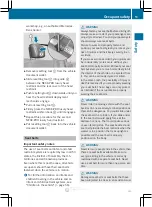
section must never be exploited in a reckless
or dangerous manner which could jeopardize
the user's safety or the safety of others.
Always adjust your driving style to the
prevailing road and weather conditions and
keep a safe distance to other road users and
objects on the street.
If a driving system malfunctions, other driving
safety systems may also switch off. Observe
indicator and warning lamps that may come
on as well as messages in the multifunction
display that may appear.
i
Please note that the driving safety
systems described only work as effectively
as possible when there is adequate contact
between the tires and the road surface. Pay
particular attention to the information
regarding tires, recommended minimum
tire tread depths etc. in the "Wheels and
tires" section (
In wintry driving conditions, always use
winter tires (M+S tires) and if necessary,
snow chains. Only in this way will the
driving safety systems described in this
section work as effectively as possible.
ABS (Anti-lock Braking System)
Important safety notes
i
Observe the "Important safety notes"
ABS regulates brake pressure in such a way
that the wheels do not lock when you brake.
This allows you to continue steering the
vehicle when braking.
ABS works from a speed of about
5 mph(8 km/h) upwards, regardless of road-
surface conditions. ABS works on slippery
surfaces, even when you only brake gently.
If the ABS malfunctions, other driving systems
such as the BAS or the ESP
®
are also switched
off. Observe indicator and warning lamps that
may come on as well as messages in the
multifunction display that may appear.
If the ABS malfunctions, the wheels may lock
during hard braking, reducing the steering
capability and extending the braking distance.
The
!
warning lamp in the instrument
cluster lights up when the ignition is switched
on. It goes out when the engine is running.
Braking
If ABS intervenes when braking, you will feel
a pulsing in the brake pedal.
X
If ABS intervenes: continue to depress the
brake pedal with force until the braking
situation is over.
X
To make a full brake application:
depress the brake pedal with full force.
The pulsating brake pedal can be an
indication of hazardous road conditions, and
functions as a reminder to take extra care
while driving.
Do not pump the brake pedal. Use firm, steady
brake pedal pressure instead. Pumping the
brake pedal defeats the purpose of the ABS
and significantly reduces braking
effectiveness.
i
Observe the "Important safety notes"
BAS operates in emergency braking
situations. If you depress the brake pedal
quickly, BAS automatically boosts the braking
force, thus shortening the stopping distance.
X
Keep the brake pedal firmly depressed until
the emergency braking situation is over.
ABS prevents the wheels from locking.
The brakes will function as usual once you
release the brake pedal. BAS is deactivated.
Driving safety systems
65
Safety
Z
Summary of Contents for R 350 2012
Page 1: ...R Class Operator s Manual I n f o r m a t i o nP r o v i d e db y ...
Page 4: ...I n f o r m a t i o nP r o v i d e db y ...
Page 28: ...26 I n f o r m a t i o nP r o v i d e db y ...
Page 38: ...36 I n f o r m a t i o nP r o v i d e db y ...
Page 72: ...70 I n f o r m a t i o nP r o v i d e db y ...
Page 96: ...94 I n f o r m a t i o nP r o v i d e db y ...
Page 130: ...128 I n f o r m a t i o nP r o v i d e db y ...
Page 198: ...196 I n f o r m a t i o nP r o v i d e db y ...
Page 282: ...280 I n f o r m a t i o nP r o v i d e db y ...
Page 322: ...320 I n f o r m a t i o nP r o v i d e db y ...
Page 352: ...350 I n f o r m a t i o nP r o v i d e db y ...
Page 364: ...362 I n f o r m a t i o nP r o v i d e db y ...
Page 365: ...363 I n f o r m a t i o nP r o v i d e db y ...
Page 366: ...364 I n f o r m a t i o nP r o v i d e db y ...
















































